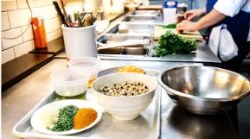Safety
All restaurants are required to follow food safety regulations. These include proper hand-washing, ensuring that foods come from a safe source and are stored in the right place at the correct temperature. Food must also be cooked properly and properly handled to prevent cross-contamination.
Food safety
Bacteria grows best between 7°C / 45°C and 60°C / 140°F, which is why there is strict regulation about the temperatures used in cooking of meats and the storage temperatures of all food groups. The cooling of hot food to be stored in the cooler must be completed within 4 hours. Shallow containers aid quick cooling in the refrigerator when covered loosely. Stirring with a clean spoon occasionally will help it cool and when cooled should be covered tightly.
Food that is to be kept hot should be kept at 60°C / 140°F and food being reheated must reach an internal temperature of 74°C / 165 °F. Restaurant refrigerators should store food at a temperature of 4.4°C / 40 °F or less. Food in the freezer should be stored at -18°C / 0 °F. Use a refrigerator/freezer thermometer to verify the correct temperature.
HACCP
The Hazard Analysis Critical Control Points (HACCP) system was developed to ensure the safety of food and has proven to be highly effective as it deals with food from the time it is delivered in the restaurant to the time it is served to diners.
Deliveries
When food arrives at the restaurant it must be checked. Frozen food must arrive at a temperature of -18°C / 0 °F and there should be no indicators that the product has started to thaw. Produce should read 4.4°C / 40 °F. Dry goods should be in packaging that is intact and canned goods should not have bulges, dents, leaks or rust. The goods should also be within the printed expiry date. If these standards are not met, refuse the goods.
Storage
Your storage area should be considered as far as you start planning the whole restaurant layout. Date all the boxes you put away for storage, particularly items that perish fast such as pre-sliced meats or produce and make sure you use the first box that came in. Allow room for air to circulate around the product, which means you never store boxes on the floor of a freezer or refrigerator. Keep canned and dry goods off the floor to stop contamination from floor cleaning and keep cleaning supplies away from the food store to stop any contamination from possible leaks from these chemicals.


